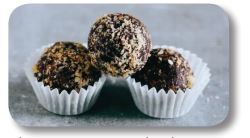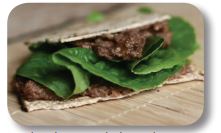Posted on March 15, 2021
Charoset is the star of the Seder plate. Amidst the parsley and lamb shanks, this sweet, sticky treat teases and tantalizes as we make our way through the storytelling, evoking the mortar used by the enslaved Israelites. Through the centuries, Jews have spread across the four corners of the earth and brought the story of the Exodus and the celebration of Passover to every land.
Uganda: Tziporah Sizomu’s Charoset Recipe
Tziporah Sizomu is a leader in the Abayudaya community in Uganda. Passover is an especially meaningful holiday for the Abayudaya. Her husband Gershom is the community rabbi and Tziporah is responsible for the holiday meals eaten together by the Abayudaya as a community. Apples are expensive, as they must be imported from South Africa, while peanuts, known as groundnuts, are local to Uganda. This charoset makes a fabulous spread for matzoh all week long! (If you do not eat peanuts during Passover, you can replace them with cashews or other nuts.)
Ingredients:
4 cups roasted peanuts
3 apples, chopped fine
2 bananas, chopped into small pieces
½ cup honey
½ cup sweet wine
Directions:
Grind the peanuts in a blender and place them in a medium-sized bowl. Mix with the chopped apples and bananas. Add the wine and stir. Add the honey and mix everything together. (If it isn’t thick enough, add more peanuts or cashews.)
Guatemala: A Modern Twist
The members of Adat Shalom, Guatemala’s only Reform community, have created a unique take on charoset. It was a big hit at last year’s Seder in Guatemala City, and it will be at yours, too.
Ingredients:
4 apples, peeled, cored, and finely chopped
½ c. sweet red wine (such as Manischewitz)
1 ½ tsp. ground cinnamon
3 T. maple syrup
5 oz. of plain refried red beans, with no seasonings
4 oz. of chopped almonds
Directions:
Chop the apples by hand as finely as possible and press them with a fork. Add the rest of the ingredients. mixing everything well. The beans should be added at the end, depending on how juicy the apple is, so that the charoset thickens. After plating, add a little of the almonds as decoration.
With time, the recipes for charoset reflected local ingredients, tastes and cultures. Whether you make one, two or all eight of the classic and modern recipes here, we doubt you’ll be able to wait until the Seder to taste these outstanding variations!
Seven-Fruit Charoset from Surinam
The Surinam Jewish community is the oldest in the Americas. Originally from Spain, these Jews resettled in Brazil for a time, and eventually established a community in Surinam.  Coconut is the base of Surinam charoset, and the ingredients reflect the tropical source of this recipe. Originally, Surinam cherries were simmered and added to the fresh fruits. Today, since most cherries available do not have the same taste, cherry jam is used instead. Some families replace one or two of the ingredients with peaches or pineapple. This recipe comes from Mrs. Irma Robles Lopes Cardozo z”l
Coconut is the base of Surinam charoset, and the ingredients reflect the tropical source of this recipe. Originally, Surinam cherries were simmered and added to the fresh fruits. Today, since most cherries available do not have the same taste, cherry jam is used instead. Some families replace one or two of the ingredients with peaches or pineapple. This recipe comes from Mrs. Irma Robles Lopes Cardozo z”l
Ingredients:
3 c. unsweetened coconut
2 c. walnuts or almonds, chopped
¼ c. sugar 1 ½ c. raisins
1 ½ c. dried apples
1 ½ c. prunes or plums
½ c. cherry jam
1 c. sweet red wine
1 T. cinnamon
Directions:
In a large bowl, cover the dried fruit with water. Soak overnight in the refrigerator to soften. The next day, finely dice all the fruit.
In a large saucepan over low heat, add the ground coconut. Add the wine and bring to a simmer. Add the nuts and sugar. Keep stirring to prevent the coconut from sticking to the pan.
When the wine and coconut mixture is well combined (neither too wet nor too dry), add the fruits, continuing to stir until the ingredients have come together. Stir in the cherry jam.
Remove from heat. Add cinnamon and mix thoroughly. Keep refrigerated until ready to serve.
Source: jamiegeller.com, July 14, 2011
Cuba: Mango and Pineapple Charoset Balls
For Jennifer “The Cuban Reuben” Stempel, blogging about food allows her to explore her twin Jewish and Cuban heritages. This Cuban charoset is her own invention, inspired by the island flavors that influence so much of her cooking. While most charoset is served as a paste, Stempel drew on the Sephardic tradition of making charoset into small balls for this unique take on a classic dish.
Ingredients:
5 oz. dried unsweetened mango, coarsely chopped
8 oz. dried unsweetened pineapple, coarsely chopped
½ c. almond slivers, toasted
2 c. shredded coconut, toasted and separated
Directions:
In a small bowl, soak the mango in hot water for half an hour. Drain well, and place in a food processor. Add pineapple, almonds, and 1 cup of the coconut to the mango in the food processor, and pulse only until the mixture starts to form a ball. There should still be some visible chunks.
Form the mixture into bite-sized balls, and set atop a pan lined with wax paper. In a small bowl, add the last cup of shredded coconut. Roll the balls in the coconut until they are lightly coated, and return them to the wax paper. Refrigerate the balls for 1 hour or until set.
Source: Jewish&, a blog by Be’chol Lashon, which gives voice to the racial, ethnic and cultural diversity of Jewish identity and experience.
Moroccan Charoset Balls
 Moroccans roll charoset into balls and place individual servings on each plate. That’s what I always remembered in my grandmother’s home, and that’s what I do today. This is my great grandmother’s authentic charoset recipe, straight from Casablanca.
Moroccans roll charoset into balls and place individual servings on each plate. That’s what I always remembered in my grandmother’s home, and that’s what I do today. This is my great grandmother’s authentic charoset recipe, straight from Casablanca.
Ingredients:
1 c. walnuts (almonds can be substituted)
1 green apple, peeled and cubed
½ c. pitted dates
½ c. raisins
½ c. pitted prunes
2 tsp. grape juice
½ tsp. cinnamon
½ tsp. sugar
Directions:
Place all the ingredients in a blender and blend to desired consistency. Some prefer their Moroccan charoset more textured and nutty; others prefer to puree more and achieve a smoother consistency. Shape into balls and refrigerate until ready to serve.
Source: Lauren Dadoun, jamiegeller.com, July 14, 2011
Persian Charoset (Haleg)
Persian charoset or haleg is fabulous! See the notes below for some time-saving shortcuts.
Ingredients:
1 6-oz. package ground walnuts (1-½ c.)
1 6-oz. package ground almonds (1-½ c.)
½ c. pistachio nut meats, ground
1 c. date paste or chopped dates
½ c. raisins, ground
½ c. grape juice
1 banana, peeled and ground
1 apple, peeled and ground
2 T. charoset spice
Directions:
Grind together – either by hand in a mortar and pestle or by using quick pulses in a food processor – all the ingredients that do not come already ground. Combine very well. 
Notes: I buy already-ground walnuts and almonds to make my life easier. I also purchase date paste so I don’t have to grind that either. These are easily available kosher-for-Passover at many kosher groceries. The rest of the ingredients I process together into a wet paste similar in texture to hummus. Charoset spice is made by Sadaf and is available online; or simply mix equal parts of cardamom, ginger, and cinnamon. Keep the haleg refrigerated, and if it gets too thick, thin it with grape juice or even sweet wine to give it a grown-up twist!
Source: Reyna Simnegar, jamiegeller.com, March 14, 2012
Greece: Traditional Greek Charoset Recipe
Sarah Aroeste’s familial roots in Greece trace all the way back to the expulsion of Jews from Spain. A vocal artist, she has dedicated her career to modernizing Ladino classics and creating new music that captures the vibrancy of the Jewish experience. For Passover, she draws on traditional Greek customs and makes this fruity recipe that gets its punch from a variety of spices.
Ingredients:
1 c. black currants, finely chopped
1 c. raisins, finely chopped
1 c. dates, finely chopped and then mashed (if they are very dry, soak them in boiling water for 10 minutes)
Pinch of grated orange rind
Cinnamon, allspice, cloves, nutmeg to taste
Sweet red wine.
Directions:
Chop all the ingredients as finely as possible. Mash them into a paste with a mortar and pestle, or briefly process in a food processor. Moisten as necessary with the red wine. Makes 3 cups.
Source: Jewish&, a blog by Be’chol Lashon, which gives voice to the racial, ethnic and cultural diversity of Jewish identity and experience.
Originally published in the March-April 2021 issue of the Shofar. For more issues of the Shofar, visit the Shofar archives.